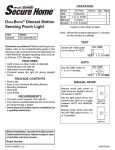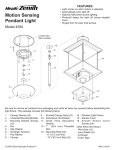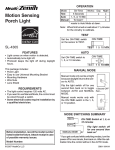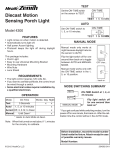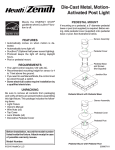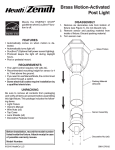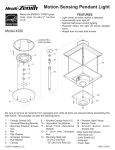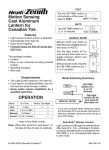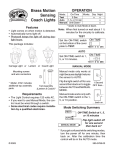Download Desa PF-4305 User's Manual
Transcript
OPERATION Motion Sensing Porch Light Mode: On-Time Test 5 Sec Auto 1, 5, or 10 min Manual Until Dawn* Works: Day Night x x x x * resets to Auto Mode at dawn. Note: When first turned on wait about 1 1/2 minutes for the circuitry to calibrate. TEST ON-TIME Set the ON-TIME switch on the sensor to TEST. TEST 1 5 10 MIN AUTO PF-4305 FEATURES Set ON-TIME switch to 1, 5, or 10 minutes. • Light comes on when motion is detected. • Automatically turns light off. • Photocell keeps the light off during daylight hours. This package includes: • Porch Light • Easy to use Universal Mounting Bracket • Mounting Hardware • Wire Nuts • Lens Shield REQUIREMENTS • The Light Control requires 120 volts AC. • If you want to use Manual Mode, the control must be wired through a switch. • Some electrical codes require installation by a qualified electrician. ON-TIME TEST 1 5 10 MIN MANUAL MODE Manual mode only works at night because daylight returns the sensor to AUTO. Flip the light switch off for one second then back on to toggle between AUTO and MANUAL MODE. 1 Second OFF then... Manual mode works only with the ON-TIME switch in the 1, 5, or 10 position. ... back on. MODE SWITCHING SUMMARY TEST AUTO Before installation, record the model number listed inside the fixture. Attach receipt in case of possible warranty issues. Model Number: © 2006 DESA Specialty Products™ MANUAL MODE ON-TIME Switch at 1, 5, or 10 minutes Flip light switch off for one second then back on* * If you get confused while switching modes, turn the power off for one minute, then back on. After the calibration time the control will be in the AUTO mode. 598-1168-03 DISASSEMBLE LIGHT FIXTURE INSTALL UNIVERSAL MOUNTING BRACKET 1. Remove two decorative nuts from light fixture cover. 2. Remove cover from base. For best performance, mount the fixture at least 8 feet (2.4 m) above the ground. WARNING: Turn power off at circuit breaker. 1. Tighten the two fixture screws finger tight. 2. Attach universal mounting bracket to junction box securely with the two screws provided. Light Fixture Base Y IVIT SIT SEN LO -M - HI 10 5 E 1 T -TIM TESON MIN Junction Box Light Fixture Cover Universal Mounting Bracket Decorative Nut Junction Box Screw 3. Remove two decorative nuts from fixture screws in universal mounting bracket. 4. Remove universal mounting bracket from base. Fixture Screw (Tightened Finger Tight) WIRING LIGHT FIXTURE 1. Connect the junction box wires and the fixture wires together as shown in the following diagrams. Universal Mounting Bracket CAUTION: DO NOT remove wire connector from RED wire or connect the RED wire unless you want to control other lights from this motion sensor fixture. Decorative Nut 2. Twist and secure wires with wire nuts. SE ITIV NS LO -M ITY - HI 10 5 1 IME ST -T TE ON MIN Note: If you have a metal junction box use the recommended grounding method shown in the following illustration. If you are uncertain about the grounding method, consult your local building code. 2 598-1168-03 Other Wiring Options Bare Ground Wire Ground Screw This fixture can be wired to control another standard or motion sensing light fixture(s). See the following wiring diagrams for proper connections. Note: All wiring should be run in accordance with the National Electrical Code through conduit or another acceptable means. Contact a qualified electrician if there is any question as to the suitability of the system. When controlling an additional light fixture(s), the maximum wattage of the motion sensor on this fixture should be observed. See illustration below for an example of a maximum lamp wattage load calculation. Metal Junction Box Pigtail (not supplied) White to White Fixture Bare Ground Wire Black to Black Recommended Grounding Method Black to Black Maximum Lamp Wattage Rating for Light Fixture – 100 Watts White to White Maximum Load for Motion Sensor – 500 Watts Ground to Ground CONTROLLING Fixture Maximum Lamp Wattage Rating for Light Fixture – 100 Watts CONTROLLED Fixture 1 Maximum Lamp Wattage Rating for Light Fixture – 100 Watts CONTROLLED Fixture 2 One Motion Sensing Light Black to Black TOTAL Load for Motion Sensor – 300 Watts (200 Watts Remaining) White to White Ground to Ground IMPORTANT: When determining the maximum lamp wattage rating of the fixture to be controlled, refer to the maximum lamp wattage label on the fixture and not the wattage rating on the lamp(s) currently installed in the fixture. Two Motion Sensing Lights (Working Independently) White to White Black to Black Red to Black Ground to Ground Motion Sensing Light Standard Light Fixture Wiring Motion Sensing Light to Control Standard Fixture 598-1168-03 3 Black to Black White to White TESTING Black to Red and Black 1. Turn on the circuit breaker and light switch. Red to Black Note: Sensor has a 1 1/2 minute warm up period before it will detect motion. When first turned on wait 1 1/2 minutes. Ground to Ground 2. Set the SENSITIVITY switch to the “M” position and the ON-TIME switch to the TEST position. Motion Sensing Light Controlled Motion Sensing Light SENSITIVITY Wiring Motion Sensing Light to Control Another Motion Sensing Light It is also possible to wire two motion sensing lights so that either unit will turn on both lights at the same time (dual controlled system). It is recommended that only people with electrical wiring experience attempt this configuration. Please call our customer service number (1-800-858-8501) before attempting this wiring. If the dual controlled wiring is not done correctly, it can destroy both motion sensing fixtures and void your warranty. SE ITY ITIV NS LO -M LO - M - HI - HI 10 5 1 IME ST -T TE ON MI N Sensor Lens TEST 1 5 10 MIN ON-TIME 3. Walk through the coverage area noting where you are when the lights turn on. In TEST mode, light will stay on for only 5 seconds then turn off. 4. Adjust the SENSITIVITY to increase or decrease the range as needed. Too much sensitivity may cause false triggering due to heat sources in the coverage area (see Adjustment of Coverage Area or Troubleshooting section). 5. Set the amount of TIME you want the light to stay on after motion is detected (1, 5, or 10 minutes). INSTALL FIXTURE BASE TO JUNCTION BOX 1. Push wires into the junction box. 2. Slide light fixture base onto fixture screws and tighten decorative nuts snugly against the base. 3. Install four candelabra base light bulbs (25 Watts maximum each). 4. Refer to TESTING section before installing cover. 5. After switches are set and testing is complete, use the 2 decorative nuts to install the cover. 360° Junction Box 8 ft. (2.4 m) Fixture Screw 25 Watt Candelabra Base Bulb Decorative Nut 30 Feet (9.1 m) in all Directions Maximum Range Angle* Coverage (Top View) * Without lens shield installed. VITY SE ITI NS LO -M - HI 10 5 1 IME ST -T TE ON MI N 4 598-1168-03 The sensor is less sensitive to motion directly towards it and more sensitive to motion across coverage area. 1. Break off the amount of lens shield needed to block the desired area of coverage. 2. Cut desired amount of foam tape needed to adhere the lens shield to the sensor lens. 3. Remove paper backing from one side of cut foam tape and adhere foam tape to inside of lens shield. 4. Remove paper backing from other side of cut foam tape and adhere lens shield to sensor lens. Motion Motion Sensor Least Sensitive SE Most Sensitive ITY ITIV NS LO -M -H I M 10 5 1 IME ST -T TE ON IN Adjustment of Coverage Area The sensor on this light fixture detects “motion” by the movement of heat (body heat) across the coverage area. However, following are examples of objects that also produce heat and can cause the sensor to false trigger: • Pools of Water • Air Conditioners • Dryer Vents • Fenced-In Animals • Heating Vents • Automobile Traffic If you suspect that a heat source of this type is falsely triggering the sensor and reducing the sensitivity does not solve the problem, then a lens shield (included) can be installed. The plastic lens shield is divided into 6 sections. Each section will reduce the coverage angle by 30 degrees. Also, the tip of each section may be removed to change the effective range of the sensor. Lens Shield Lens Shield Lens Shield 5. Retest to confirm that the sensor is no longer false triggering. Note: To help determine amount of lens shield required, apply small sections one at a time. Additional sections can be applied if necessary. SPECIFICATIONS Range ........................... Up to 30 ft. (9.1 m) [varies with surrounding temperature]. Sensing Angle .............. 360° Electrical Load .............. Up to 100 Watt Maximum Incandescent (Up to 25 Watt Maximum each lampholder). Bulb Type ...................... Candelabra Base, Type “B”, 25 Watt Maximum Sensor Capacity ........... Up to 500 Watt (4.2 A.) Maximum Power Requirements .... 120 VAC, 60 Hz Operating Modes .......... TEST, AUTO, and MANUAL MODE ON-Timer ...................... 1, 5, 10 minutes Area Blocked Effective Coverage Area (Top View) Area Blocked DESA Specialty Products™ reserves the right to discontinue products and to change specifications at any time without incurring any obligation to incorporate new features in products previously sold. Portion Removed 598-1168-03 Sensor Lens 5 TROUBLESHOOTING GUIDE SYMPTOM SYMPTOM POSSIBLE CAUSE POSSIBLE CAUSE Light will not 1. Light switch is turned off. come on. 2. Bulbs are loose or burned out. 3. Fuse is blown or circuit breaker is turned off. 4. Daylight turn-off is in effect (recheck after dark). 5. Incorrect circuit wiring, if this is a new installation. Light stays on 1. There is a heat source like an continuously. air vent, dryer vent, or brightlypainted, heat-reflective surface in the coverage area. (Install shield on sensor in the direction of heat source.) 2. Sensitivity is set too high. (Reduce sensitivity.) Light comes on 1. Sensor may be installed in a in daylight. relatively dark location. 2. Sensor is in Test. (Set control switch to an ON-TIME position.) Light flashes on 1. Sensor is in the Test mode. (While and off. in TEST mode, light only stays on for 5 seconds.) Light does not 1. Nearby large, light-colored objects stay on in Manreflecting light may trigger the ual mode. shut-off feature. Do not point other lights at the sensor. Light comes on 1. Sensor may be sensing small for no apparent animals or automobile traffic. reason. (Reduce sensitivity.) TECHNICAL SERVICE Please call 1-800-858-8501 for assistance before returning product to store. If you experience a problem, follow this guide. You may also want to visit our Web site at: www.desatech. com. If the problem persists, call* for assistance at 1-800-858-8501, 7:30 AM to 4:30 PM CST (M-F). You may also write* to: DESA Specialty Products™ P.O. Box 90004, Bowling Green, KY 42102-9004 ATTN: Technical Service Specialty Products * If contacting Technical Service, please have the following information available: Model Number, Date of Purchase, and Place of Purchase. No Service Parts Available for this Product THREE YEAR LIMITED WARRANTY This is a “Limited Warranty” which gives you specific legal rights. You may also have other rights which vary from state to state or province to province. For a period of three years from the date of purchase, any malfunction caused by factory defective parts or workmanship will be corrected at no charge to you. Not Covered - Repair service, adjustment and calibration due to misuse, abuse or negligence, light bulbs, batteries, and other expendable items are not covered by this warranty. Unauthorized service or modification of the product or of any furnished component will void this warranty in its entirety. This warranty does not include reimbursement for inconvenience, installation, setup time, loss of use, unauthorized service, or return shipping charges. This warranty covers only DESA Specialty Products™ assembled products and is not extended to other equipment and components that a customer uses in conjunction with our products. THIS WARRANTY IS EXPRESSLY IN LIEU OF ALL OTHER WARRANTIES, EXPRESS OR IMPLIED, INCLUDING ANY WARRANTY, REPRESENTATION OR CONDITION OF MERCHANT ABILITY OR THAT THE PRODUCTS ARE FIT FOR ANY PARTICULAR PURPOSE OR USE, AND SPECIFICALLY IN LIEU OF ALL SPECIAL, INDIRECT, INCIDENTAL, OR CONSEQUENTIAL DAMAGES. REPAIR OR REPLACEMENT SHALL BE THE SOLE REMEDY OF THE CUSTOMER AND THERE SHALL BE NO LIABILITY ON THE PART OF DESA SPECIALTY PRODUCTS™ FOR ANY SPECIAL, INDIRECT, INCIDENTAL, OR CONSEQUENTIAL DAMAGES, INCLUDING BUT NOT LIMITED TO ANY LOSS OF BUSINESS OR PROFITS, WHETHER OR NOT FORESEEABLE. Some states or provinces do not allow the exclusion or limitation of incidental or consequential damages, so the above limitation or exclusion may not apply to you. Proof of purchase is required for warranty claims. 6 598-1168-03 Nota: Cuando lo prenda por primera vez espere 1 1 /2 minutos para que el circuito se claibre. PRUEBA Ponga el interruptor de ON-TIME ON-TIME (DURACIÓN) del detector en TEST (PRUEBA). TEST 1 5 10 MIN Lámpara de portal con detector de movimiento AUTOMATICO Ponga el interruptor de tiempo (ON-TIME) en la posición de 1, 5 ó 10 minutos. TEST 1 5 10 MIN MODO MANUAL PF-4305 El modo manual funciona sólo por la noche porque la luz del día pone al detector en modo AUTOMATICO. Apague el interruptor por un segundo y vuélvalo a prender. El modo manual funciona sólo cuando el interruptor de tiempo (ON-TIME) está en la posición de 1, 5 ó 10 minutos. CARACTERÍSTICAS • La luz se prende cuando se detecta movimiento. • Apaga la luz automáticamente. • La fotocélula mantiene la luz apagada durante las horas del día. Este paquete contiene: • Lámpara del pórtico • Soporte universal de fácil uso • Ferretería de montaje • Conectores de alambre • Cubierta de la placa traslúcida REQUISITOS RESUMEN DE LAS MODALIDADES DEL INTERRUPTOR PRUEBA FUNCIONAMIENTO A tiempo: Prueba 5 seg. Autom. 1, 5 ó 10 min. 1 segundo APAGADO luego... ...préndalo. • El Control de Luz requiere 120 VCA. • Para usar el Sobrecontrol Manual, conecte el control con un interruptor. • Algunos códigos requieren instalación por un electricista calificado. Modalidad: ON-TIME Trabaja: Día Noche x AUTOM. x x MODO MANUAL Manual Hasta el x amanecer* *Se pone en Automático al amanecer. Mueva el interruptor de tiempo (ON-TIME) a 1, 5 ó 10 minutos Apague el interruptor por un segundo y préndalo de nuevo* * Si se confunde mientras cambia de fases, apague la electricidad por un minuto y préndala de nuevo. Después del tiempo de calibración el control estará en fase AUTO(MATICA). Antes de instalar, registre el número del modelo mostrado dentro del aparato. Fije el recibo en caso posibles reclamos por la garantía. Número del modelo: 598-1168-03 © 2006 DESA Specialty Products™ 7 598-1168-03 S DESARME EL APARATO DE LUZ INSTALE EL SOPORTE UNIVERSAL DE MONTAJE 1. Retire las dos tuercas decorativas de la tapa del aparato de luz. 2. Retire la tapa de la base. Para un mejor desempeño, monte el aparato al menos a 2,4m del suelo. ADVERTENCIA: Desconecte la energía en el disyuntor. 1. Apriete a mano los dos tornillos del aparato. 2. Sujete bien el soporte universal de montaje a la caja de empalme usando los dos tornillos provistos. Base del aparato de luz Y IVIT SIT SEN LO -M - HI 10 5 E 1 T -TIM TESON MIN Tapa del aparato de luz Caja de empalme Tuerca decorativa Soporte universal de montaje Tornillo de la caja de empalme 3. En el soporte universal de montaje retire de los tornillos del aparato las dos tuercas decorativas. 4. Retire de la base el soporte universal de montaje. Tornillo del aparato (apretado a mano) CABLEADO DEL APARATO DE LUZ 1. Conecte los conductores de la caja de empalme apretándolos juntos con los conductores del aparato como se muestra en los esquemas que siguen. Soporte universal de montaje Tuerca decorativa CUIDADO: NO retire el conector de alambre del conductor rojo ni conecte el conductor ROJO a no ser que desee controlar otras luces desde este aparato detector de movimiento. SE ITIV NS LO -M 2. Tuerza y asegure los conductores con conectores de alambre. ITY - HI 10 5 1 IME ST -T TE ON MIN Nota: Si tiene una caja de empalme metálica use el método de conexión a tierra recomendado que se indica en la siguiente ilustración. Si tiene dudas del método de conexión a tierra, consulte el código local de construcción. 8 598-1168-03 Cuando controle aparato(s) de luz adicionales, debe observarse la potencia máxima del detector de movimiento de este aparato.Vea en la ilustración de abajo un ejemplo para el cálculo de la potencia máxima de la lámpara. Conductor desnudo de conexión a tierra Tornillo de conexión a tierra Conductor flexible (no provisto) Caja metálica de empalme Conductor desnudo del aparato para conexión a tierra Potencia nominal máxima de la lámpara para el aparato de luz – 100 vatios Blanco con Blanco Carga máxima para el detector de movimiento – 500 vatios Negro con Negro Método recomendado de conexión a tierra Aparato DE CONTROL Aparato CONTROLADO 1 Negro con Negro Aparato CONTROLADO 2 Blanco con Blanco Potencia nominal máxima de la lámpara para el aparato de luz – 100 vatios Potencia nominal máxima de la lámpara para el aparato de luz – 100 vatios Carga TOTAL del detector de movimiento – 300 vatios (200 vatios no usado) Conductor tierra con Conductor tierra IMPORTANTE: Cuando determine la potencia nominal máxima de la lámpara del aparato a ser controlado vea la potencia máxima en la etiqueta del aparato y no la potencia nominal en las lámparas que están actualmente instaladas en el aparato. Blanco con Blanco Una lámpara detectora de movimiento Negro con Negro Rojo con Negro Conductor tierra con Conductor tierra Conductor tierra con Conductor tierra Negro con Negro Blanco con Blanco Aparato de luz detector de movimiento Aparato estándar de luz Cableado del aparato de luz detector de movimiento para controlar un aparato de luz estándar Dos lámparas detectoras de movimiento (trabajando independientemente) Blanco con Blanco Otras opciones de cableado Este aparato puede cablearse para controlar otro(s) aparato(s) de luz estándar o detectores de movimiento. Vea en los siguientes esquemas las conexiones apropiadas. Nota: Todo el cableado debe ser hecho de acuerdo al Código Eléctrico Nacional por medio de conductos para cables u otras formas aceptables. Póngase en contacto con un electricista calificado si existe duda sobre la aptitud del sistema. 598-1168-03 Negro con Negro Rojo con Negro Negro con el Rojo y el Negro Conductor tierra con Conductor tierra Aparato de luz detector de movimiento Luz detectora de movimiento controlada Luz detectora de movimiento que controla otra luz detectora de movimiento 9 PRUEBA Es también posible cablear dos luces detectoras de movimiento de modo que cualquiera de ellas encienda ambas luces al mismo tiempo (sistema de control doble). Se recomienda que sólo personas con amplios conocimientos de electricidad conecten este tipo de configuración. Por favor contacto con nuestro departamento de asistencia al cliente antes hacer este tipo de conexión (vea Servicio Técnico). Si el cableado del control doble no es hecho correctamente, puede destruir ambos aparatos detectores de movimiento e invalidad su garantía. 1. Prenda el cortacircuitos y el interruptor de luz. Nota: El detector tiene un período de cerca de 1 1/2 minutos de calentamiento antes de detectar movimiento. Cuando lo prenda por primera vez, espere 1 1/2 minutos. 2. Calibre el interruptor SENSITIVITY (SENSIBILIDAD) poniéndolo en la posición “M” y el interruptor “ON TIME” (“DURACIÓN”) en la posición TEST (PRUEBA). INSTALE LA BASE DEL APARATO A LA CAJA DE EMPALME SENSITIVITY 1. Empuje los conductores hacia la caja de empalme. 2. Deslice la base del aparato por los tornillos del aparato y apriete bien las tuercas decorativas contra la base. 3. Instale cuatro bombillas con base tipo candelabro (de máximo 25 vatios cada una). 4. Antes de instalar la tapa vea la sección PRUEBA. 5. Luego de calibrar los interruptores y completar la prueba, use las 2 tuercas decorativas para instalar la tapa. SE -M - HI MI N LO - M - HI Placa traslúcida del detector TEST 1 5 10 MIN ON-TIME 3. Camine por el área de protección dándose cuenta dónde está cuando la luz se prende. En la fase PRUEBA, la luz se encenderá sólo 5 segundos y luego se apagará. 4. Regule la SENSIBILIDAD para aumentar o disminuir el margen según sea necesario. Demasiada sensibilidad puede ocasionar activaciones falsas debido a fuentes de calor en las áreas de cobertura (Vea Regulación del área de cobertura o la sección Guia de investigacion de averias). 5. Fije el período de tiempo (ON-TIME) que la luz debe quedarse prendida después de detectar movimiento (1, 5 ó 10 minutos). Caja de empalme Tornillo del aparato Bombilla de 25 vatios con base tipo candelabro Tuerca decorativa ITY ITIV NS LO 10 5 1 IME ST -T TE ON 360° 2.4 m VITY SE ITI NS LO -M - HI 10 5 1 IME ST -T TE ON MI N 9.1m en todas las direcciones Alcance Máximo Angulo de Cobertura Máxima* (Vista desde arriba) * Sin la cubierta de la placa traslúcida instalada. 10 598-1168-03 2. Corte la canti- Cubierta de la placa traslúcida dad necesaria de cinta espumosa que necesita para adherir la cubierta a la placa traslúcida. Placa traslúcida del detector 3. Retire el papel protector de un lado de la cinta espumosa y adhiérala al interior de la cubierta. 4. Retire el papel protector del otro lado de la cinta espumosa cortada y adhiera la cubierta a la placa traslúcida del detector. 5. Vuelva a probar para confirmar que el detector ya no presenta activaciones erróneas. Nota: Para ayudar a determinar la cantidad de cubierta requerida en la placa traslúcida, ponga las secciones pequeñas una por vez. Si es necesario puede añadir secciones. El detector es menos sensible a movimientos hacia el detector y más sensible a movimientos transversales en el área de cobertura. ITY SE ITIV NS LO Movimiento Detector Lo menos sensible Lo más sensible REGULACIÓN DEL ÁREA DE COBERTURA El detector de este aparato de luz detecta “movimiento” gracias al movimiento del calor (calor corporal) a través del área de cobertura. Sin embargo, lo que sigue son ejemplos de objetos que pueden también producir calor y hacer que el detector se active erróneamente. • Charcos de agua • Acondicionadores de aire • Respiraderos de secadoras • Respiraderos de la calefacción • Animales tras las vallas • Tráfico automotor Si usted sospecha que una fuente de calor de este tipo está activando erróneamente el detector y que reduciendo la sensibilidad no soluciona el problema, entonces puede instalarse la cubierta de la placa traslúcida (incluida). La cubierta plástica de la placa traslúcida está dividida en 6 secciones. Cada sección reducirá el área de cobertura en 30 grados. Además, puede retirarse la punta de cada sección para cambiar el alcance efectivo de cada detector. Cubierta de la placa traslúcida Área efectiva de cobertura (Vista desde arriba) MIN ESPECIFICACIONES Alcance ............................. Hasta 9.1 m (varía con la temperatura del medio ambiente). Angulo de detección ......... 360° Carga Eléctrica ................. H a s t a 1 0 0 V a t i o s máximo de luz incandescente (hasta 25V máximo por cada portalámparas). Tipo de bombilla ............... Base candelabro, tipo “B” de 25 vatios máximo Capacidad del Detector .... Hasta 500 Vatios (4.2 A) máximo Requisitos de Energía ...... 120 VCA, 60 Hz Fases de Operación ......... FASES DE PRUEBA, AUTOMÁTICO Y MANUAL Temporizador de duración (del encendido) ...........1, 5, 10 minutos Área bloqueada Área bloqueada DESA Specialty Products™ se reserva el derecho de descontinuar productos y de cambiar especificaciones a cualquier momento sin incurrir en ninguna obligación de tener que incorporar nuevas características en los productos vendidos con anterioridad. Parte retirada 1. Rompa la cantidad necesaria de cubierta que necesita para bloquear una área deseada de la cobertura. 598-1168-03 - HI 10 5 1 ME ST TI TE ON- Movimiento Cubierta de la placa traslúcida -M 11 GUIA DE INVESTIGACION DE AVERIAS SINTOMA SINTOMA POSIBLE CAUSA La luz no se 1. El interruptor de luz está apagado. enciende. 2. Las bombillas están flojas o quemadas. 3. El fusible está quemado o el cortacircuitos está apagado. 4. La desconexión de luz del día está en efecto. (Compruébelo al anochecer). 5. Alambrado incorrecto, si ésta es una nueva instalación. POSIBLE CAUSA La luz se queda 1. Hay una fuente de calor como ventoprendida contisas de aire, respiradero de secadora, nua-mente. o hay en el área de cobertura una superficie brillante que refleja calor. (Instale la cubierta en el detector en la dirección de la fuente de calor). 2. La Sensibilidad es demasiado alta. (Apague el Aumento de Distancia). La luz se prende 1. El detector está en la fase Prueba. y se apaga. (Mientras está en la fase PRUEBA, la luz sólo queda encendida por 5 segundos). La luz se prende 1. El detector debe ser instalado en durante el día. un lugar relativamente oscuro. 2. El detector esta en la posición prueba. (Fije el interruptor del control a la posición de TIEMPO). La luz no queda 1. Objetos cercanos, grandes y de encendida en el colores brillantes que reflejan luz modo manual. pueden activar la característica de apagado. No apunte otras luces hacia el detector. La luz se prende 1. El detector puede estar detectando sin ninguna raanimales pequeños o tráfico autozón aparente. motor. (Reduzca la sensibilidad). SERVICIO TÉCNICO (No enviar los productos) Si tiene algún problema por favor siga esta guía. Lo sentimos, pero no podemos contestar preguntas en español por teléfono. Usted puede también escribir* a: DESA Specialty Products™ P.O. Box 90004 Bowling Green, KY 42102-9004 * Si se llama al Servicio Técnico, por favor tener lista la siguiente información: Número de Modelo, Fecha de compra y Lugar de compra. No hay piezas de servicio disponibles para este producto. GARANTÍA LIMITADA A 3 AÑOS Esta es una “Garantía Limitada” que le da a Ud. derechos legales específicos. Usted puede también tener otros derechos que varían de estado a estado o de provincia a provincia. Por un período de 3 años desde la fecha de compra, cualquier mal funcionamiento ocasionado por partes defectuosas de fábrica o mano de obra será corregido sin cargo para Ud. No cubierto - Servicio de reparación, ajuste y calibración debido al mal uso, abuso o negligencia, bombillas, baterías, u otras partes fungibles no están cubiertas por esta garantía. Los Servicios no autorizados o modificaciones del producto o de cualquier componente que se provee invalidarán esta garantía en su totalidad. Esta garantía no incluye reembolso por inconveniencia, instalación, tiempo de instalación, perdida de uso, servicio no autorizado, o costos de transporte de retorno. Esta garantía cubre solamente los productos ensamblados por DESA Specialty Products™ y no se extiende a otros equipos o componentes que el consumidor usa junto con nuestros productos. ESTA GARANTÍA ESTÁ EXPRESAMENTE EN LUGAR DE OTRAS GARANTÍAS, EXPRESADAS O SOBREENTENDIDAS, INCLUYENDO CUALQUIER GARANTÍA, REPRESENTACIÓN O CONDICIÓN DE COMERCIABILIDAD O QUE LOS PRODUCTOS SE ADAPTEN PARA CUALQUIER PROPÓSITO O USO EN PARTICULAR, Y ESPECIFICAMENTE EN LUGAR DE TODOS LOS DAÑOS ESPECIALES, INDIRECTOS, INCIDENTALES Y CONSECUENTES. LA REPARACIÓN O EL REEMPLAZO DEBERÍA SER LA ÚNICA SOLUCIÓN DEL CLIENTE Y NO HABRÁ RESPONSABILIDAD POR PARTE DE DESA SPECIALTY PRODUCTS™ POR CUALQUIER DAÑO ESPECIAL, INDIRECTO, INCIDENTAL O CONSECUENTE, INCLUIDOS PERO NO LIMITADOS A CUALQUIER PÉRDIDA DE NEGOCIO O GANACIAS SEAN O NO PREVISIBLES. Algunos estados o provincias no permiten la exclusión o limitación de daños incidentales o consecuentes, de modo que la limitación o exclusión arriba indicada puede que no se aplique a Ud. Para reclamos por la garantía se requiere la prueba de compra. 12 598-1168-03
This document in other languages
- español: Desa PF-4305












